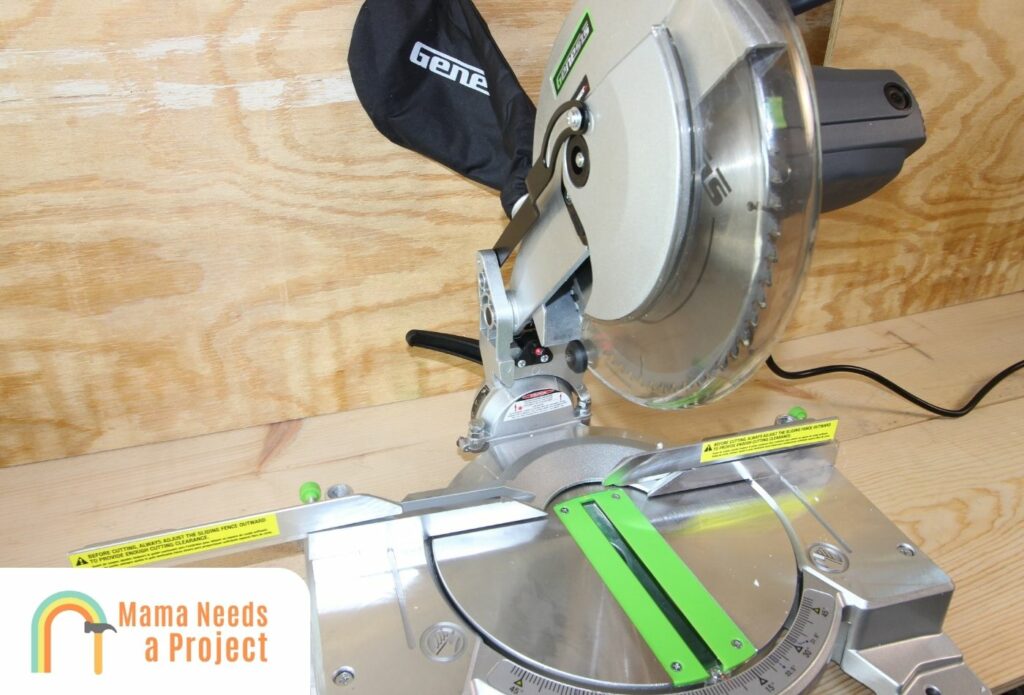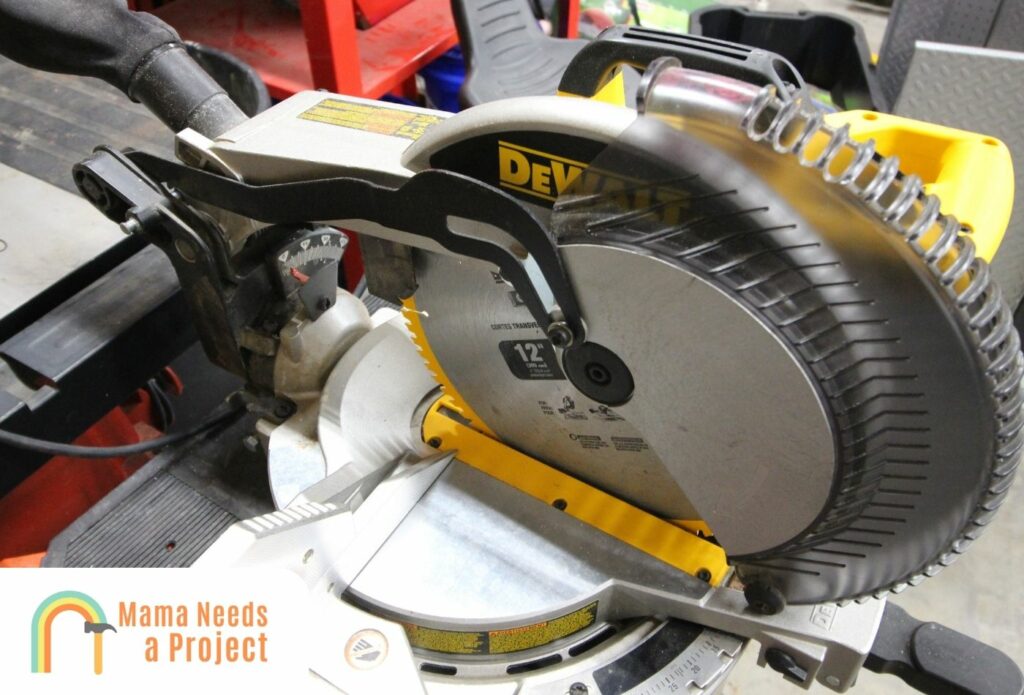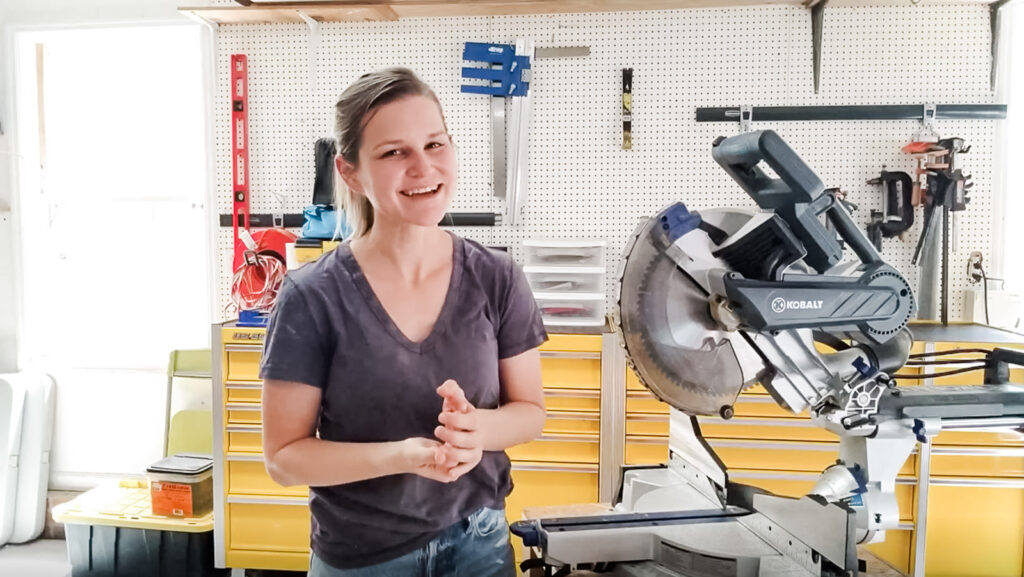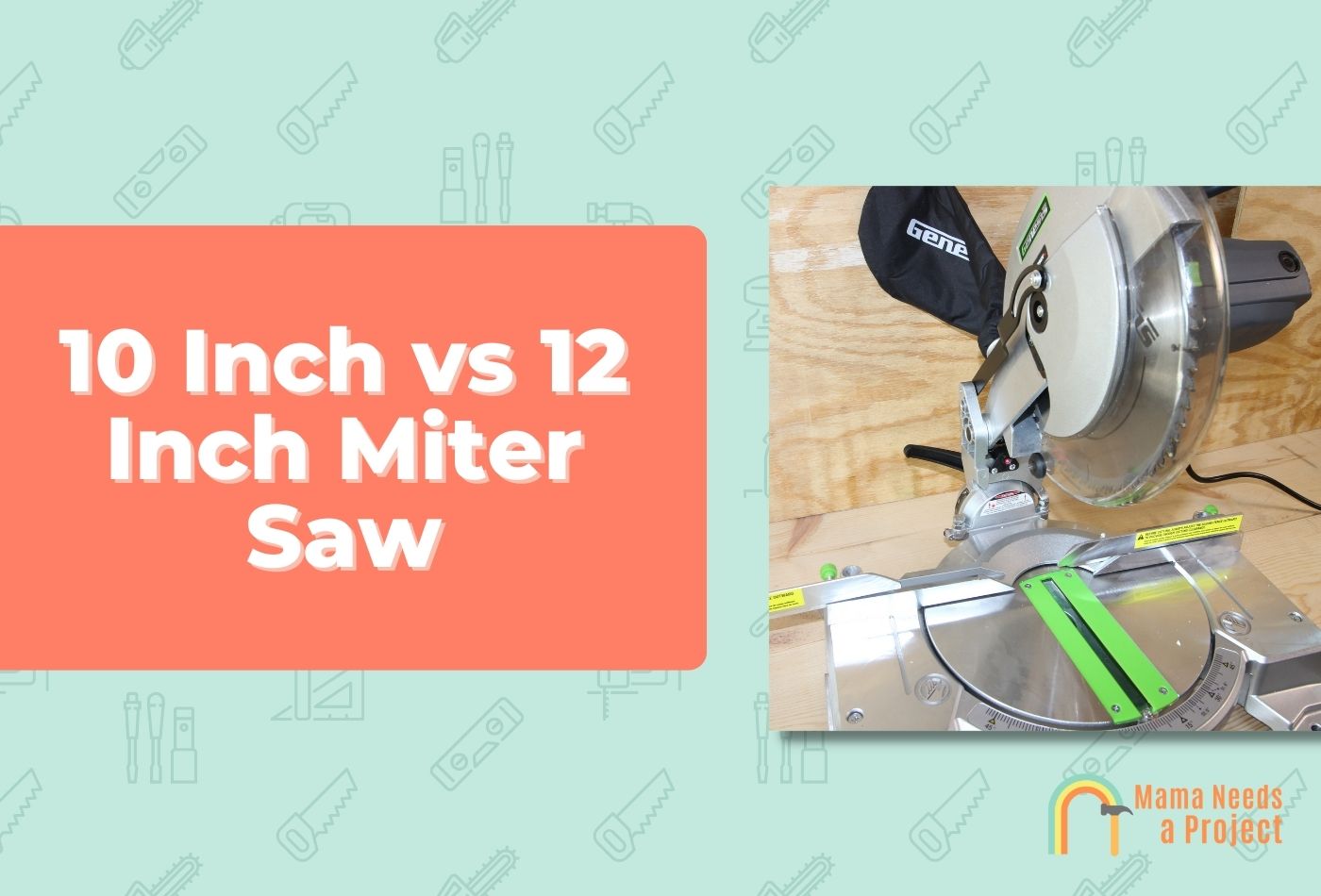10 Inch vs 12 Inch Miter Saw: Which is Better?
When it comes to woodworking, having the right tools is essential for producing accurate, clean, and efficient cuts.
And one of my most commonly used tools in my woodshop is my miter saw. These saws are super convenient and can be used to make all sorts of cuts.
But there are plenty of options when it comes to miter saws, and one of the big ones is size.
Both of these saws have their advantages and drawbacks, and your choice will ultimately depend on the type of projects you typically work on.
In this post, I’ll compare a 10 inch vs 12 inch miter saw so you can find the best saw for your needs. Let’s dig in!
- A 10-inch miter saw is affordable, portable, and suitable for smaller projects that don’t require a large cutting capacity.
- A 12-inch miter saw offers a deeper cutting capacity, ideal for larger workpieces or heavy-duty tasks.
- If you’re completing basic DIY projects that don’t require heavy duty cutting, a 10 inch miter saw should do the trick. If you’re working with thicker boards that need the extra cutting capacity – go with a 12 inch miter saw.
10 Inch Miter Saw

Cutting Capacity
When it comes to cutting capacity, the 10-inch miter saw does quite well with smaller projects. Thanks to its smaller blade size, you can make more accurate cuts, especially when you’re working on tasks like trimming baseboards or cutting crown molding.
When you compare this to an even smaller 8 1/4 inch miter saw – this is a great medium sized saw that can get most day to day jobs done and is perfect for beginners.
Portability
One thing I really appreciate about my 10-inch miter saw is its portability.
It’s lighter and smaller than 12-inch miter saws, which makes it easier for me to move it around my workspace or take it with me on the go.
If you’re woodworking in a small place, the smaller size can be a huge benefit.
Looking for a 10-inch miter saw? Check out these best 10″ miter saws or these amazing compact miter saws!
Price
Another advantage of 10-inch miter saws is their affordability.
Typically, they’re a decent amount cheaper than their 12-inch counterparts – but this isn’t necessarily always the case.
It’s also worth noting that I’ve found that 10-inch saw blades tend to cost less than 12″ saw blades – which saves you money down the road.
When to Buy a 10″ Miter Saw
A 10-inch miter saw is best for people who frequently work on projects that involve cutting smaller materials, like trim work, molding, and other simple DIY projects. Since a 10-inch blade has a smaller radius, it tends to spin faster, ultimately resulting in cleaner and more accurate cuts. Additionally, I’ve found that 10-inch miter saws are generally cheaper, as both the saw itself and the replacement saw blades tend to cost much less than 12 inch miter saws.
In summary, I’d recommend buying a 10-inch miter saw for the following reasons:
- Cutting smaller materials, such as trim work and molding
- Requiring cleaner, more precise cuts
- Budget limitations
- Needing a portable, easy-to-transport saw
Just remember, if you’re working with very thick or wide materials, a 10-inch miter saw may not be the best option, as it usually has a maximum cutting capacity of around 4 1/2 inches. In that case, you may want to consider a 12-inch miter saw.
12 Inch Miter Saw

Cutting Capacity
There’s one main difference when it comes to a 10 inch vs 12 inch miter saw – the cutting capacity.
As the name suggests, a 12″ miter saw features a 12″ saw blade that allows for a higher cutting capacity than a 10″ miter saw.
This means if you’re cutting thicker boards that require the extra capacity, going with a 12″ saw makes perfect sense.
Power and Performance
In terms of power, 12″ miter saws usually feature higher amp motors that can power the larger blade size.
The more powerful motor allows you to make smoother cuts on harder materials than smaller saws – which is extremely important for some people.
Check out this guide on cutting aluminum with a miter saw to learn a few tips and tricks!
Price
As you probably expect, a larger saw is going to cost more than a smaller saw – so you can expect to pay around 15% to 25% more for a 12″ miter saw than you would a 10″ model.
That said, there are tons of variations in pricing so you can find a great 12″ budget miter saw for about the same price as some more advanced 10″ saws.
When to Buy a 12″ Miter Saw
So, when should you opt for a 12″ model?
First and foremost, if you’re working on projects with thicker or wider materials, a 12-inch miter saw can provide increased cut capacity than its 10-inch counterpart. This comes in handy when cutting through hard materials or large boards, as the larger blade size allows for deeper cuts.
Another reason to opt for a 12″ miter saw is if you need more power. In most cases, the larger saw will feature a more powerful motor that’s capable of making smooth cuts without a problem.
Lastly, a 12-inch miter saw is the way to go for professionals or people tackling advanced woodworking projects on a regular basis.
The larger blade size and increased power offer better performance and versatility, making it easier for me to handle a wide range of tasks with just one tool. While the 12-inch saw is typically more expensive, I think it’s a worthwhile purchase for those who need the added capabilities.
Basically, If you’re making larger cuts, on denser materials – go with a 12″ miter saw.
Comparing Advantages and Disadvantages

Accuracy and Precision
In my experience, both 10-inch and 12-inch miter saws can provide great accuracy and precision when cutting materials. However, I’ve noticed that 10-inch saws tend to have slightly better blade rotation speeds, which can sometimes result in cleaner cuts.
That said, 12-inch miter saws offer a larger cutting capacity, making them the go-to choice for larger woodworking projects like furniture.
Safety Features
In terms of safety, there really isn’t much of a difference when comparing a 10 inch vs 12 inch miter saw.
Both should have blade guards, large stop buttons, and other safety features that make them safe to operate.
Versatility
Both of these saws are extremely versatile and can make just about any cut you might need.
The 10-inch miter saw has the advantage of being more affordable and readily available, making it an excellent choice for casual users, enthusiasts, or those with a limited budget.
However, the 12-inch miter saw is more suitable for larger and complex projects due to its increased cutting capacity and ability to handle thicker materials. Despite being more expensive, it’s a great saw for professionals or frequent users.
Selecting the Right Saw for Your Needs

As someone who has used both 10-inch and 12-inch miter saws, I can confidentially nudge you in the right direction based on your needs.
Project Types
When it comes to the types of projects you’ll be working on, the size of your miter saw can make a big difference.
If you’re working on smaller projects where precision is key – you want to go with the smaller 10″ saw. The smaller blade can allow you to make more accurate, precise cuts on thinner woods and materials.
On the other hand, a 12-inch miter saw has greater cutting capacity and is more suitable for larger and thicker materials. So, if you’re like me and work on a wide range of projects, you might want to consider the versatility of the 12-inch saw.
Need help using a miter saw? Check out this awesome video below!
Workspace Requirements
Not everyone is lucky enough to have a large workshop to house their tools!
While the actual dimensions of the saws won’t be a massive difference, every inch counts when you’re working in a small space.
If you have a small space, opting for the smaller saw is the right choice.
If you need a stand for your miter saw, I highly recommend on of these miter saw stands!
Budget
As I’ve discussed, a 12″ miter saw is slightly more expensive than most 10″ models, but it will vary depending on the brand.
Alternatively, you can use one of these amazing miter boxes to save some cash on your cuts.
FAQs
Is a 12-inch miter saw better than a 10-inch?
Ultimately, both of these miter saws are very similar other than their size. The 12″ has a larger saw blade that is more capable of heavy duty cutting. If you’re working on larger projects, then a 12″ miter saw is a better option. However, if you’re working on smaller projects, a 10″ saw will do just fine.
Final Thoughts
A 10-inch miter saw is a great choice if you prioritize precision, price, and portability. It’s easier to transport and generally more affordable. Another advantage of the 10-inch is that the blades are more readily available and cost significantly less than the 12-inch blades. This saw is perfect for smaller woodworking projects and home improvement tasks that don’t require cutting very large pieces of material.
On the other hand, the 12-inch miter saw offers a larger cutting capacity which can be crucial for some woodworking projects. Its larger blade allows you to break down thick glue-ups, table legs, and wide boards. The drawback of the 12-inch saw lies in the higher price tag and larger size.
If you’re a professional working on large projects, go with a 12″ miter saw.
If you’re a casual woodworker or using the saw for basic home improvement jobs – a 10″ miter saw should be more than capable.

